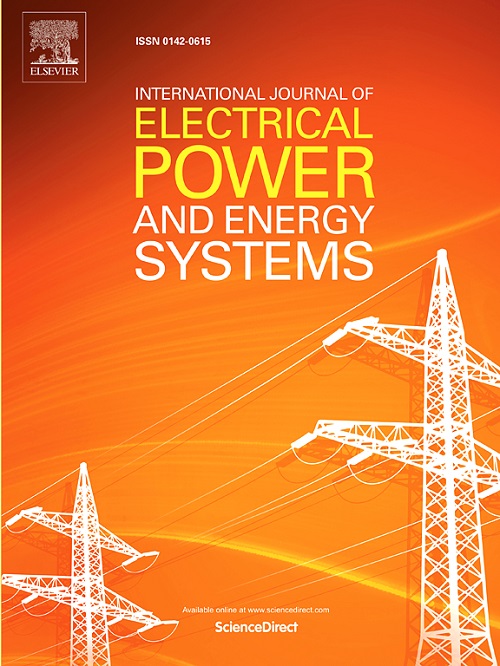基于鲁棒深度神经网络的物联网电力变压器不平衡不确定故障诊断
IF 5
2区 工程技术
Q1 ENGINEERING, ELECTRICAL & ELECTRONIC
International Journal of Electrical Power & Energy Systems
Pub Date : 2025-05-12
DOI:10.1016/j.ijepes.2025.110731
引用次数: 0
摘要
电力变压器是电力系统中最重要的部件之一,它是向消费者供电的其他设备链中的重要一环。根据文献,Duval五边形法(DPM)是最准确、最可靠的溶解气体分析(DGA)解释方法之一。然而,在DPM中实现大量数据仍然具有挑战性,并且存在一些限制。为了克服这些限制,本文引入了一种鲁棒深度神经网络(DNN)方法来精确监测DGA。另一个优点是提出了合成少数过采样技术-编辑最近邻(SMOTE-ENN)预处理,以消除不平衡数据集中的噪声,从而获得更干净的合并DGA样本。此外,采用了一种独特的鲁棒标量技术来保持对不确定数据噪声的高性能。为了实现变压器故障的远程可视化,提高对变压器状态的决策速度,本文利用了工业物联网(IoT)平台。具体而言,将所设计的深度学习模型与物联网平台相结合,对传输的气体浓度DPM数据集进行分析,并通过物联网网关将分类结果发送到云端,在物联网仪表板上可视化检测到的故障。实证结果表明,该方法优于几种最先进的方法。该方法对评估数据集的故障诊断效果满意,准确率达到98.19%。实验结果表明,该模型对不确定性噪声的抗噪能力达20%,对变压器故障具有较好的预测诊断效果。本文章由计算机程序翻译,如有差异,请以英文原文为准。
Robust deep neural network-based internet of things for power transformer fault diagnosis under imbalanced data and uncertainties
One of the most vital components of power systems is power transformers, which provide an essential link in the chain of other devices used to supply electricity to consumers. According to the literature, the Duval pentagon method (DPM) is one of the most accurate and reliable dissolved gas analysis (DGA) interpretation methodologies. However, implementing large amounts of data in DPM is still challenging and has several limitations. To overcome these limitations, this paper introduces a robust deep neural network (DNN) method for precise DGA monitoring. Another merit is the proposal of synthetic minority over-sampling technique-edited nearest neighbor (SMOTE-ENN) preprocessing to eliminate noise from the imbalanced dataset, resulting in cleaner merged DGA samples. Furthermore, a unique RobustScaler technique is employed to maintain high performance against uncertain data noise. To visualize transformer faults remotely and enhance the acceleration of decision-making regarding the transformer status, this paper utilizes an industrial Internet of Things (IoT) platform. Specifically, the designed deep learning model is hybridized with an IoT platform to analyze the transferred DPM dataset of the gases concentration and send the classification results using the IoT gateway to the cloud for visualizing the detected fault on the IoT dashboard. The empirical results display that the proposed method outperforms several state-of-the-art approaches. The proposed method achieves satisfaction in diagnosing faults for the assessment dataset, with an accuracy of 98.19 %. Besides, the obtained results illustrate the effectiveness of the proposed model against uncertainty noise up to 20 % with a superior prediction diagnosis of the transformer faults.
求助全文
通过发布文献求助,成功后即可免费获取论文全文。
去求助
来源期刊
CiteScore
12.10
自引率
17.30%
发文量
1022
审稿时长
51 days
期刊介绍:
The journal covers theoretical developments in electrical power and energy systems and their applications. The coverage embraces: generation and network planning; reliability; long and short term operation; expert systems; neural networks; object oriented systems; system control centres; database and information systems; stock and parameter estimation; system security and adequacy; network theory, modelling and computation; small and large system dynamics; dynamic model identification; on-line control including load and switching control; protection; distribution systems; energy economics; impact of non-conventional systems; and man-machine interfaces.
As well as original research papers, the journal publishes short contributions, book reviews and conference reports. All papers are peer-reviewed by at least two referees.

 求助内容:
求助内容: 应助结果提醒方式:
应助结果提醒方式:


